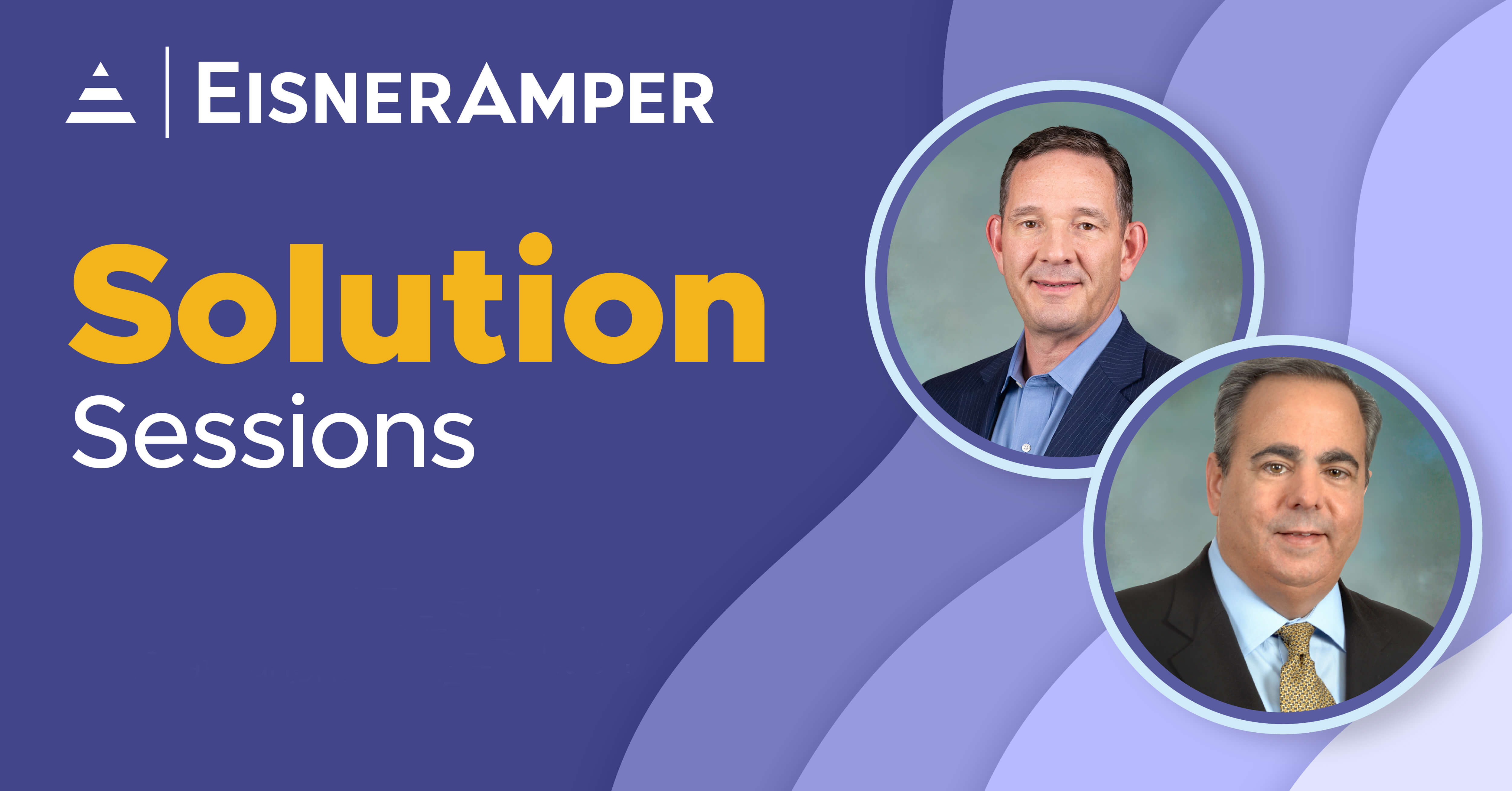Staying Ahead of California's Climate-Related Disclosure Laws
- Published
- Nov 29, 2023
- Topics
- Share
Learn how to navigate California's evolving regulatory landscape and prepare your organization for the future. These laws affect both public and private organizations conducting business in California.
Transcript
Charles Waring: Thank you, Astrid.
Good afternoon to everyone on the East Coast and good morning to folks that are on the West Coast that are joining us. I'm Charles Waring, I'm a partner here on our ESG group and I'm pleased to be joined by my colleague, Lourenco Miranda. Just to give a brief introduction of myself, I'm a partner here, I'm an auditor by trade. I've been an auditor for almost 20 years now, but been in our ESG space for over three years, and it's been great to see how this continues to grow, be a point of question and areas for our clients as they get accustomed to evolving ESG reporting. We've got the privilege to talk about, today, the California laws that have recently been enacted there. So before we get into that, I'll turn it over to Lourenco to introduce himself.
Lourenco Miranda: Thank you very much, Charles. This is Lourenco Miranda, managing director in our ESG practice here in EisnerAmper. Been with the firm for the past two years and prior to that, probably 20 years in the industry. Working in different capacities, I've seen it all. I've seen from the moment that ESG and climate risk topics were created back in Rio in 1992 until today, which is extremely exciting to see that we have a lot of participants, a lot of excitement about the topic. An extremely important topic and emerging topic that is topping the bill in terms of importance for us and for all the companies that probably will have to comply with these laws that we're going to talk today. It's nice to see that California is ahead of the pack. Thank you very much, Charles, back to you.
Charles Waring: Great. So today, this is our overview of our agenda. Lourenco will take us through the overview of the laws here. I'll just say that California has gotten out in front of the pack here. This is the first reporting requirements in the US around ESG, and I know that Lourenco will correct me, we're calling it ESG, but obviously the California one is specific to climate, to the E component here. But either way, this is the first one that's been adopted, that's put in place, and needs to be on the radars for companies that fit the requirements here.
There are certainly some key open questions. I know that talking with many of our clients, colleagues, and connections, there's certainly a lot of questions that are open and we wanted to go through that early in our presentation today because I think that there's aspects that are still being ironed out in the implementation of these two acts here. And we'll touch on some of the large ones here and give a little bit of a flavor and sense on what you might want to consider as things start to evolve.
And then I think that as everyone is probably most focused on is, if this applies to you, how do you prepare for it? How do you work within your organization to address this, to consider what's going on, what's the timetable here? What's the level of effort that goes into it, et cetera. So we'll go through that.
And then one of the things that we always like to do in our webcast, and I know that there's many folks that have joined us on prior ones, is we want to make sure that you've got some key takeaways to go back to your teams, your colleagues, and identify what are some of the things that need to be factored in and put in place there and discussions that should be happening now.
Obviously we've got time saved at the end there for questions, but as Astrid mentioned, please feel free to submit the questions throughout the presentation. Lourenco and I are monitoring them, and if something hits at the moment we might address it as it pops up, but we do have time saved to the end there.
So again, want to make sure that everyone is getting their CPEs, so please stay on for the 50 minutes as well as we'll give you the heads-up when polling questions are coming up here. So without further ado, I will turn it over to Lourenco for the overview of laws here.
Lourenco Miranda: Thank you very much, Charles. You're right, you're absolutely right, you touched on a very important point. ESG is extremely broad and has all the environmental, social, and governance elements, and here the laws are focusing on the climate part of it. So ESG, of course environment, has to do with climate, climate impacts in the society, so it is very broad, but here we are talking about very specific climate related risks.
Basically California is focusing on two laws, and they broke the problem into two, so to speak. The first one is focusing on greenhouse gas emissions. We're going to go into details of each law in a moment. But the first one is, if you're a company and you do business in California and you pass some thresholds, you have to identify, assess, and report on your greenhouse gas emissions, and we'll talk about details of that in a moment. So you have to pay attention to that, that's the first thing that you should think about.
The second thing is, there's a second law that introduces a new dimension, the disclosure of climate related financial risks. We'll see how all these climate related risks and we'll see which climate related risks will impact your financial statements, will impact your strategy, will impact your strategy not only today, but also in the future, in the middle term, and on the long term. So that's what the California government is looking for. It's looking for you to start thinking about your climate related risks, how those impact your business, and if you are identifying and assessing the greenhouse gas emissions that you are producing as part of your operations. But that's basically it, so then we're going into more details now.
So what is required by each law? So when you say that they are complimentary in each other, so they compliment each other, it's hard to do one without the other. So the SEC, we're going to talk about the comparison between these two laws and the SEC rule, the proposed rule. SEC put it all together, you have scope 1, two, and probably three emissions, as well as climate related financial risks in one big packet. Here, California separated it into two. The first one, the information that is required from companies that must comply with this law, is you have to report your scope 1, two, and three emissions. And attention here to scope 3 emissions because it's mandatory. So you have to, in 2027, start reporting on your scope 3 emissions. And we'll talk a bit about how to prepare for that and how to implement it, how difficult that is for companies that can have a very complex supply chain.
So for the first rule, scope 1, two, and three emissions for the climate corporate data, the requirement begins in 2026 for data that is based on 2025 data. So we start, 2025, reporting 2026 for scope 1 and two, and scope 3 in 2027 using 2026 data. So we will see that you'll have to start calling your suppliers right now, if you haven't done already, and ask for information. And if you're a supplier of a company that has to comply with this law, you'll be receiving the call or will be receiving the emails very soon.
A big topic item here that we want to emphasize, which is different from the SEC, here private companies are part of the pack. So private and public companies doing business in California with an annual revenue for more than $1 billion, they must comply with the Climate Corporate Data Accountability Act or they must reply to this law. To comply with this law, they have to report scope 1, two, and three emissions regardless if you're public or private. But that's a big change in the game here. When we had before, we didn't have private companies being targeted directly by a law, now we do.
And the penalty, if you don't comply with this law, your penalty is up to $500,000. It's more or less how much you're probably going to spend in order to comply with the law, so it's going to be a matter of deciding in first year if I want to invest money in order to bring my company into a different level in terms of sustainability and climate change awareness, or pay the penalty from now on. There will be a moment that this is going to start being very costly for you as a company if you don't start complying with it.
On the right-hand side on the other side of the column, there is the Climate Related Financial Risk Act. What does that mean? It means that companies that have an annual revenue more than $500 million, and they do business in California, will have to start identifying, assessing, and reporting on their climate related financial risks. There are two types of climate related risks that you have to start paying attention to. The first one is physical risk, and the second one is transition risk. The physical risks is related to a direct impact of a climate or a weather or a severe weather event in your business like a hurricane, a wildfire, flood, drought. If your business is in a region that is prone to drought or to hurricanes or wildfires, and in California we know that that is the case, you have to start identifying and reporting those physical risks. Meaning that if there is a physical risk event, a hurricane or drought or wildfire impacting your business, you have to identify and quantify that risk and how much that will impact in your balance sheet. That's what's required.
So you have to start reporting it though, and the penalty for this is $50,000 in a reporting year for failure to comply. So you have to start reporting in the beginning of 2026 based on 2025 data. It takes time. It can be a very time-consuming process. It takes time in order to start identifying all these risks, creating a process, creating internal controls, developing those testing, so it's a lot of work that has to be put in order to comply with this rule.
One thing that these two laws do not define is what it means to be doing business in California. But the state of California Franchise Tax Board defines it as an entity that which meets any, and here I want to emphasize the 'any', of the following: First, engages in any transaction for the purpose of financial gain in California. It's organized or commercially domiciled in California. It has California sales property or payroll that exceeds certain pre-defined amounts. The link for those amounts is there in the bottom of the page so you can access that. We have different thresholds, but the ”any” clause there is very powerful, it's very decisive. If you engage in any transaction for the purpose of financial gain in California, if you already qualify for that, if you're already engaging in any transaction for the purpose of financial gain within California, it doesn't matter if your payroll exceeds certain pre-defined amounts because it's any, in any of the following.
So that's, in a nutshell, the requirements of the two laws. We're going to get into details on how to prepare for those, but in a nutshell, those are the basic requirements.
Charles Waring: Lourenco, we've got a couple questions that have come in here that I think are worth addressing as they relate to some of the questions related to the thresholds here, and I think I'm going to lump a couple of these together here. When we're talking about these revenue thresholds, are we considering them both gross or net? And then also is it just in California? Is it totality beyond just California? So can you speak to those two aspects here?
Lourenco Miranda: Right, so that's a very good question. Excellent question. The law is clear, you have an entity in the United States, the whole entity, if the gross revenue is more than $1 billion, not necessarily only in California, but if you are based out of Atlanta in Georgia and your company is $1 billion revenues elsewhere and you do business in California, you have to report it. So that's how the language of the legislation is written. Nothing specifies that you have to be gross revenue in California of more than 1 billion, no, it's your entity. If the entity has more than $1 billion in revenue and you do business in California, if you meet any of these requirements, yes, and then you have to comply with the law.
And then it's interesting because the follow-up question for this will be, will we have to report only the greenhouse gas emissions that my operations in the state of California will produce? And the law says no, we have to report at the entity level as well. So if you are not in California, but you do business in California, you have to comply with the rule, if you of course pass all these marks, and you have to report on a consolidated basis.
And then I see, will New York be next? Yes, good question. New York is very well advanced in terms of regulations for financial institutions. So NYDFS has climate related very similar rules for financial institutions. If you are an insurance company doing business in New York, you have to comply with a series of regulations that are related to climate. And then maybe, we don't know yet so we have no information on this one, but New York could be next. The thing is, if your company is based in New York and does business in California, there you go. And of course goes and passes all the criteria here stated on this slide, yes, you have to comply with... Well, maybe a company in New York that is part of a supply chain of a company that does business in California and then has to comply with this, might be receiving a call or an email very shortly to start getting greenhouse gas emissions because the company that has to comply with this rule, scope 3 emissions, are the scope 1 and two emissions of their suppliers. So that's the thing. So if you're a supplier of a company that does business in California and has to comply with this rule, you have to provide that information for that company as well. So it's a very far reach of this. The regulation has a very wide net.
I hope it helps. I hope it answers the question.
Astrid Garcia: So it looks like we're coming up to polling question number two.
Lourenco Miranda: Yes, the polling question- oh, go ahead, please, sorry.
Astrid Garcia: Polling Question #2
Lourenco Miranda: Thank you so much. One of the things that I use to memorize this, to learn this, is that the lower number, you have 253 and then you have 261, 253 comes first. What comes first? Is it the greenhouse gas emissions or the other risks? So do you remember that the table, what comes first, greenhouse gas emissions or the impact on the financial standing of the company? So 253 is either a greenhouse gas or risks.
Lourenco Miranda: So the Senate Bill Number 253 mandates businesses to assess the greenhouse gas emissions reporting. So 253 is greenhouse gas emissions, 261 is that climate change can impact the financial state. It's the opposite. It's false. 253 is greenhouse gas emissions, 261 is the risks. 261 risks, 253, greenhouse gas emissions.
Charles Waring: Okay, so I'll take it from here as we move into the next piece. And, Lourenco, thank you for the overview of the California laws here. So as we mentioned, and Lourenco alluded to some of the components here, there's still some open questions, right? When the legislation was signed into law by Governor Newsom, he did provide some commentary that we'll get into here, and that's the first piece. So the start date for compliance as it's currently written in the legislation... But Governor Newsom made the comment that it might be a little aggressive. So as it stands right now, reporting, which for both of these laws would start in 2026, and that would be over 2025 data.
So the aspect around is that, 2024, we're expecting the California Air Resource Board, which is the agency in California that's charged with implementing these acts as well as where reporting would be provided to, so that's another little nuanced difference between the SEC's rule and the California laws, is that this is being owned by a environmental agency within the state here. And so that's an aspect that is important for us to consider. But what we're looking at and expecting is that the nuances and some of these open questions, the details, et cetera, for the implementation of this, CARB will be rolling out that information in the coming months in '24, which would entail also if there's any change in the timeline for implementation, et cetera, here. So that's the one thing that we know that the governor made a specific comment around.
But I think that at the same time, these are now officially enacted. There could be challenges in the courts, but again, they're being structured differently than the SEC's rule and I think that the important thing is that right now you should be having conversations around, is this going to be impacting your organization? And there's other components around that, we'll get into that in a second, but either way, even if it's delayed a year, there is still effort here if you haven't been doing climate and emissions reporting yet. It's not something that you just flip the switch one day and start doing. So there's an aspect around, even if it's a delayed a year, that organizations should be taking that time to putting in the proper processes and controls and reporting that's necessary, and Lourenco will get into that in a minute here.
The other component here is the definition of doing business in California. Now, again, the details of what that means is not specified in the law. However, as Lourenco referenced, the taxing authority in California does have some components within what they define as doing business in California, and that's what was incorporated in the prior slide. Now, CARB could be adopting those components, they could be tweaking, enhancing, raising the bar on it, there could be adjustments to that. But again, I think that the taxing authorities' definition here would be the kind of floor. Which again, you should think about is that something that is affecting or putting your organization into the category of doing business? There might be more clarity around that going forward or CARB could just adopt what the taxing authority has specified there.
I think the other component was one of our questions that was answered on the other slide, is around the total revenue thresholds outside of California. That is, speaking with a couple attorney friends, that's one thing that could be challenged as it relates to potentially regulating commerce outside of the state of California, but that's to be determined. Either way, I think that California put a lot of effort into the drafting and the specifying of these requirements and these thresholds. So again, what I would advise you to consider is that if you're currently meeting these thresholds, you should, again, start to think about what does this mean to your organization? But there could be further clarity coming on this as well.
The other aspect is the subsidiary versus corporate reporting. Depending on your legal entity structure, if you've got wholly owned sub in California or you've got an investment or however the split is, the law is just written, as Lourenco mentioned, at the entity level. And so the aspect around if you've got something that is wholly owned and doesn't do separate external reporting and it all rolls up into your overall corporate structure, that would likely put an aspect around bringing the overall corporate entity into the requirements of these laws here. Again, could have more clarity around that, but right now it's written as entity and it doesn't really specify a nuance between subs or if they're fully owned or if there's a different type of ownership or control structure that's in place there.
Last but not least, certainly not least, is scope 3. So obviously I think that some of you have joined us on prior webcasts, the quick component and reminder of scope 1, two, and three are: emissions that are directly resulting of the operations of your organization are what we call scope 1. scope 2 emissions are related to the emissions associated with the power or your utilities, your electricity, how that was generated. But then scope 3 is the emissions that is coming from your value chain. So there are suppliers that are providing all your inputs, both raw materials, any sort of transportation aspects here that's coming to your company, and then also the outputs. So whatever it takes to deliver your product to the consumer, to the final buyer of your services there, that's all considered in your value chain. And so if you've got suppliers or other third parties that are used in the delivery of your products, those would be looped into a scope 3 considerations.
Now, Lourenco, I'll ask you to chime in because there are nuances around how this would be calculated. I mean, it's a complex area. I mean, what are some of the scope 3 questions or details that we're expecting to be clarified from California in the coming months on scope 3?
Lourenco Miranda: Yeah, scope 3... Thanks Charles. The scope 3 has always been a big question mark. It's a definition that comes from the greenhouse gas protocol, GHG protocol, and defines, as you mentioned, the emissions that comes from your supply chain downstream and upstream. So scope 3, usually, the most impactful are the products and services that you acquire from third parties and all the products and goods that you sell to third parties. That's probably the two most impactful ones. I think the number one question mark here is, how do you know what's the proportion of that greenhouse gas emission from that specific vendor is due to me, it belongs to me, it's because I am doing business with that third party. That's called attribution, in a technical term for scope 3.
So scope 3 attribution is a big question mark, and most of the attributions are done by estimates or done by proportions, they have to use a metric or an indicator of revenue, could be a size. What kind of size revenue or indicator that you use, criteria is going to be either arbitrary or an estimate. So scope 3 is a big question mark. What's the level of requirement or level of accuracy that the California government will require for scope 3 is going to be still open.
We have a question here from audience. I work for a global company that has a few divisions that do business in California. Do we have to report on all activities of our company, both in other states within the US and other global locations, or just activities that are related to transactions in California? Well that's, to Charles's point, that's exactly what is a big open question. It could be legally challenged, because California regulating on business outside of the state, that's a big question mark. But as of today, as the law is written, it is entity. Again, could change.
Charles Waring: Yeah, I think that, to that question, certainly you should be prepared for California activities and I think that just knowing some of the other California laws related to their privacy laws, et cetera, there's an aspect around if you're US based operations, those ones should be kind of on the back burner. But I think that, again, the entity component hasn't been broken down to specify just those operations, just those entities, in California. And so I think that that's something that we're expecting more clarity around, but certainly you should be looking at those operations, those components, that are in California at this time but should also consider those other aspects within the US.
The other thing I just wanted to mention is that, I mean, one of the things that we often think about when we're looking at scope 3 and value chain impact here is that if an organization called, say, you've got 25 to 50 total vendors, but the top 10 are your key ones that do most of your supply. If you go in and drill into the emissions that are produced from those top 10, does that really get you to the ballpark of what you would make up for your scope 3? Again, that's a common question that we're getting because what coverage do you need to have in your total operations, your total scope 3 components here? So that is something that we're also looking for clarity around from CARB here.
I think that we've got another polling question coming up, Astrid?
Astrid Garcia: Polling Question #3.
Charles Waring: And with this question, I'm going to kind of go back to a couple slides ago when Lourenco presented it. There are these built-in penalties here with non-compliance. And one of the things I would just mention for consideration is that, again, California was specific in considering the penalty knowing that if an organization thought that the implementation was going to be much more than the penalty, many of them might be opted to take the penalty versus with the compliance. The one thing I just want to call out is obviously in a year one scenario, getting all the implementing, the processes, the controls, the resources, personnel, et cetera, there's a significant investment in that certainly. And so that might be higher than this number here initially. But just like with any other setup, once you've got that initially implemented, it's anticipated that those annual recurring costs would decrease.
Now, there's also an aspect that these initiatives, the reporting that would take place, is likely also to dovetail if you have other ESG or climate related reporting requirements, i.e., the SEC if you're public, or any of the European requirements if you're impacted by those. So there's aspects that there's likely overlap here and it shouldn't be seen as simply silos for the purposes of this.
Charles Waring: Okay, great. We had 79% was true and 21% was false, which again, that is a true statement there. We appreciate that.
Lourenco, I'm going to turn it over to you to dig into how to prepare for these requirements here.
Lourenco Miranda: Thank you, Charles.
Here we are going to get one company, any company, that has to comply with the California rule, so passes through all the thresholds and has to comply with the California rules that we've just showed and discussed. Here we have a step-by-step towards compliance, a hypothetical scenario for a private California-based manufacturing company. Here I call it Power Chords Innovations, so a company specialized in energy equipment and manufacturing, it's based in California. So a lot of scope 3 there, so you have to pay attention to this. With the introduction of Senate Bill 253 and Senate Bill 261, power chords must adopt its operations to comply with the new greenhouse gas emissions reporting requirements and climate related financial risk disclosures. Here we have a five step, how to prepare for the two legislations.
The first one is the basic, answers the question where do I start? Usually that's the question that we hear from our clients, that we here in general, where do I start? We have this new rule, where do I start? What do I need to do first? I think the first thing that you need to do is assess the current state of your business related to climate risks and GHG emissions. So you first gather all the information that is necessary. Usually it's internal processes, procedures, policies, internal controls, all the communication materials that you have. Your company already produces a sustainability report. That's extremely important that you gather the information. How you produce that report, it's gold for this process. All the governance documents that you have, committee charters, presentations, and internal and external reports. So if you're a public company, you have a bunch of external reports, you have your SEC filings, so you have a lot of information already that you have that could be the kickstart for the gap assessment for the current assessment of your situation. Could be the case that you already have a lot in place and you can leverage from that.
And the second thing is you come up with a benchmark. I didn't mention before, but the second part of the rule related to climate related risks is based on TCFD, which is a Tax Force of the Climate-Related Financial Disclosures. So that's the framework that is used by the industry. It's a best practice in the industry. That's what the SEC is based also upon. California legislation also mentions TCFD and ISSB, so they mentioned those explicitly, so it's a very good start. And you understand that TCFD has four pillars: the first one being the governance. Then you move to strategy, which means that, okay, what is your future strategy, your current, short-term, medium-term, and long-term strategies that might be impacted by climate related risks. Remember the two, physical risks and transition risks. Physical risks meaning all the extreme weather events impacting your business, damage to physical assets, your disruptions of business. So we have a lot of different ways that these risks could impact your business. And you start thinking, okay, do I know all the risks that I'm impacted?
So we start creating this documentation, start creating this... Use TCFD as a questionnaire, as a starting point, to start asking yourself these questions. Then you use a maturity matrix to assess... This maturity matrix will assess you in order to put together an action plan and prioritize, because you need to know what you need to do and how much resources you have in order to implement that. So you need to understand what will go first and when and how much that will cost you. And then you produce a gap assessment report. Then you develop the action plan, and based on the gap assessment, you create an action plan with resources and timelines for compliance.
The second step, which is extremely crucial, is to train your senior management, especially the board and the C level. Sometimes these terms can be new for them and most of the times they are, especially the board. If you're a public company, if you're a private company that has a board, has a very solid governance, you need to appoint one board member maybe to be the go-to person for the climate related rules. The SEC is requiring this because TCFD requires that. So start training those. Start training not only the board and the senior management, but also your staff. You have to percolate this idea that climate related risks and the information that's needed in order to comply with the rule like the greenhouse gas emissions, they should be treated with the same importance as your financial data. So you have to start creating this culture. It's extremely important. Training, do not underestimate the impact of training and education of your board and senior management and staff.
The third step is probably the most complex. You see here there's a very complex chart, but I'm going to dissect this and then explain item by item. The step three is develop a regular reporting framework. So we have to start developing a regular annual reporting framework that will report on your greenhouse gas emissions on an annual basis. It's not something that is a one-off, it's something that you have to do all the time. Just like your financial data, your financial reporting, this will become part of it. Exactly the same timing for your financial reporting, your greenhouse gas emissions, your financial risks. If you're a public company, when the SEC kicks in, you have to start reporting those in your 10-K's, so it's going to be part of your reporting flow already. So it's not a one-off thing, you have to think about that.
So the first part of it is, okay, so what is it? What kind of information would I need and where do I find it and what do I need to do in order to report it? But the first step here on the left-hand side, scope and plan, it has three chevrons there, the first one is scope and plan. First thing is review greenhouse gas emissions accounting standards and methods for reporting. Here we are talking about the greenhouse gas protocol. Those are the standards that will define what scope 1, scope 2, and scope 3 are and how you report on those, how you identify the sources, identify the appropriate data that needs to be identified and captured, need to be analyzed, put in a repository, create all the internal controls for that, and create all the methods for reporting. If you are thinking about financial reporting, of all the internal controls of financial reporting, here is very similar. You have to take this at the same level of care that you have in your internal controls for financial reporting.
Then you have to determine organizational and operational boundaries. What does that mean? It means exactly what we're talking about in terms of the entity. Is it group? Is it just one specific part of the group? And if you have ownership over older companies, but you only have 40%, 35%, 50%, you have majority, you have not majority, you have full control, you don't have full control, so all these boundaries can become extremely complex, especially if you work in a global company. With all these boundaries, can become very, very tricky. And if you're a financial institution and you own other companies, if you're a private equity you own other companies, it also can be tricky as well.
Choose a base year, usually the year that you have the information coming from. 2021, you don't have 2020 because you never captured this before you started getting 2021. Use this as your baseline as you are reporting it that you're going to start referencing to, it's important if you want to start creating targets as well. If 2021 is your base year, all your targets could be based out of that year. I'm going to reduce my carbon footprint by 40% by 2040 or are going to be net-zero by 2050. It's going to be based on that year. That's important to come up with this as well and decide if a third party verification is required. In this case, the answer is yes, and Charles is going to talk about this in a moment.
The second step is collect data and quantity. Identify data requirements and methods for data collection, develop data collection procedures, tools and guidance. I talked about this, just exactly the same gist that you have for your internal controls for financial reporting, the same processes, the same type of processes. Of course, it's non-financial data. There is financial data, but you have to think about the same level of care and structure. Gather facility data, and you have to start thinking about the boundaries that you created when you start getting this information, estimate missing data to fill in the gaps, it's the basic data management, choose emission factors. What does that mean? If you're talking about a specific manufacturing company, any manufacturing company, and if you're buying energy from one specific company and you know that company is producing that energy coming from a coal or from oil and gas or coming from nuclear, so we need to know what is the energy mix and all the factors that have to go into account. And then formalize the data process and procedures and complete independent verification. Charles is going to talk about this and the report.
And then the risk identification and assessment, I think I mentioned this a lot already, you have two basic risks that you have to pay attention to: physical risks and transition risks. GHG emissions will measure transition risks, and based on these risks, you have to start creating links between these risks and your financial statements. I mentioned this already, if you have your production line or your facilities in different locations, you have to understand if this location is prone to hurricanes or specific weather will be important for you to start measuring. If something happens, what will be the impact in the short, medium, and long term? And how that impacts in your balance sheet and income statement, and your strategy and financial planning. So that's more or less the step three.
The idea is identify risks, identify the links between those risks and the financial statements. That's a lot of work there, so you cannot underestimate the amount of work that is related to this, and of course on an ongoing basis you have to monitor if you're compliant with the rule or not.
So Charles, step four talks about the assurance part. I'm going to hand it over to you.
Charles Waring: Great, thank you.
And one of the things that... The California law, related to the emissions piece, has a specific requirement around independent assurance here. And I think that that's an important thing that we want to mention, that just like any sort of process to get ready for an external audit, many of you might also be familiar with SOC reports and getting ready for that, it's a similar type of component here. I know that there's a lot of information in this slide, but I like to boil it down into a simple crawl, walk, run. And so if running is, you're getting your assurance being performed by a third party, you can't just jump to that running spot before you walk and crawl. Walking is really, we've got our self-reporting, we've got some of our internal processes established and formalized, and it's prepared to be in a position that an auditor can go and kick tires on and ultimately look to issue a third party assurance report over it. But first and foremost, you need to have those ESG or climate reporting programs and processes in place there as the foundation.
I think that the biggest thing I wanted to emphasize here is that, as Lourenco was mentioning, if you're a public company, you probably have already started to do some of this stuff. Either you've already got your own initiatives in place, you are anticipating the SEC's rule, but you probably have something that's starting to take you in that maturity model and that journey that would support assurance in the near term. But if you're a private company, this is something that might have not been on your radar. It might not necessarily be a critical requirement or something that's getting the exposure and the focus that if you were in the public company setup would be. And so it's important that that whole process of initiating your reporting process, doing that self-reporting internally, getting your ducks in order, and then ultimately the assurance piece, that is not something that just is, you flip the switch one day to decide to do it and boom, you've got it. There is a lot of planning, initial kind of kicking the tires, finding those warts and how you want to clean them up before it would be considered in an assurance report. Because ultimately, when you engage an assurance provider, once that process is started, they can't unsee stuff. And I think that that's important.
Now, there is an aspect that the initial assurance level is just limited assurance. It's not to the same level as your typical audited financials which would be a reasonable assurance level, but it doesn't discount the level of controls and processes and formality that needs to be in place in order for it to pass that assurance, that test there. It's an important component there to think about.
I know that we'll distribute these slides after the fact, but I think the last piece here that we've outlined is that continuous improvement. Because the one thing is that as you start doing self-reporting and then also assurance level reporting, you're going to start to see where you stand and ultimately look for ways to reduce your emissions, address your climate related risks, et cetera. Because I think that that's the unspoken aspect as far as, once you start doing these requirements and doing this reporting, what does the subsequent years look like? The reporting would go to the California Air Resource Board, CARB, but many companies might look to make their results public and use that as part of their competitive advantage within their peer group. So the aspect around reducing that, because again, these laws do not have penalties around certain level emissions or anything like that, this is just sheerly on reporting your risks, reporting your emissions there for right now.
I think we've got another poll, Astrid?
Astrid Garcia: Polling Question #4.
Charles Waring: And I think that the aspect here that we've kind of talked through is that if you are a supplier, a key supplier, for a company that might not necessarily fall into this requirement here, you should be considering if you've got a key customer that is falling into this and you would be basically scoped into their scope 3 emissions in their value chain. This is something that you should be expecting that requirement of that company coming to you and saying, hey, we need to know what your emissions, your scope 1 and 2 emissions are, because that constitutes our scope 3. And so I think that that's a key component here, is that even if you don't necessarily fall directly into the requirements here, that it's something that organizations need to be aware of.
Charles Waring: So we've got a little over 77% saying false and that is correct because of the multiple aspects around doing business in California as well as could potentially be roped in from a standpoint of the scope 3. So that's the important component for consideration here.
Lourenco, I'll kind of quickly go through our takeaway slides here, recognize we just have a few minutes left. I think that the key message that we want to emphasize is, start the conversations within your organizations now. Being able to consider... Again, we know that there's some open questions here, but this is an aspect that's not something that can easily be flip the switch and start it up. The longer that you wait, the more chances of, a, things that when you start to formulate your process, your reporting, et cetera, things that you might not necessarily like or think that is the best representation of your organization might come to light. And then your ability to address them or remediate them, fix them, are diminished and or tend to become more expensive. So it's an important aspect there.
The crawl, walk, run, you can't get to the end game without first doing those specific steps leading up to it and it's an important component there. And then again, I think that with any first round, if you haven't done initial self-reporting, you likely will find things that you want to fix. And trying to address those before you have to file, before you want to share anything publicly, that's an important component there.
We talked about the impact, that this is not just California based, but will have a ripple effect through other companies that sell or service to those companies that are subject to this. I think that there's aspects around, by following this and applying to this, you enhance corporate reputation and aspects that are being recognized within the marketplace with consumers. And then ultimately there's an aspect around that this is to drive consideration and risk management components here, that this is ultimately risk management in consideration of the impact of climate risks here and developing more resilient investments.
Lourenco, I know we're at the last minute here, but any other thoughts on key takeaways?
Lourenco Miranda: Yeah, I think you mentioned all of them. The fact that you shouldn't wait, it's a lot of work. That process that you've just seen how to prepare is extremely costly, extremely labor-intensive, so you have to start now. You cannot wait any longer. You cannot wait for six months and start thinking about this later on. The earlier you start, the more cost-effective it will become.
Charles Waring: Exactly. And so I know that we were able to address many of the questions as we went through the presentation, so thank you for submitting those. For those of you that we were not able to address your question during today's session, we will be reaching out directly to you to provide a response.
Transcribed by Rev.com
What's on Your Mind?
Start a conversation with the team
Receive the latest business insights, analysis, and perspectives from EisnerAmper professionals.













